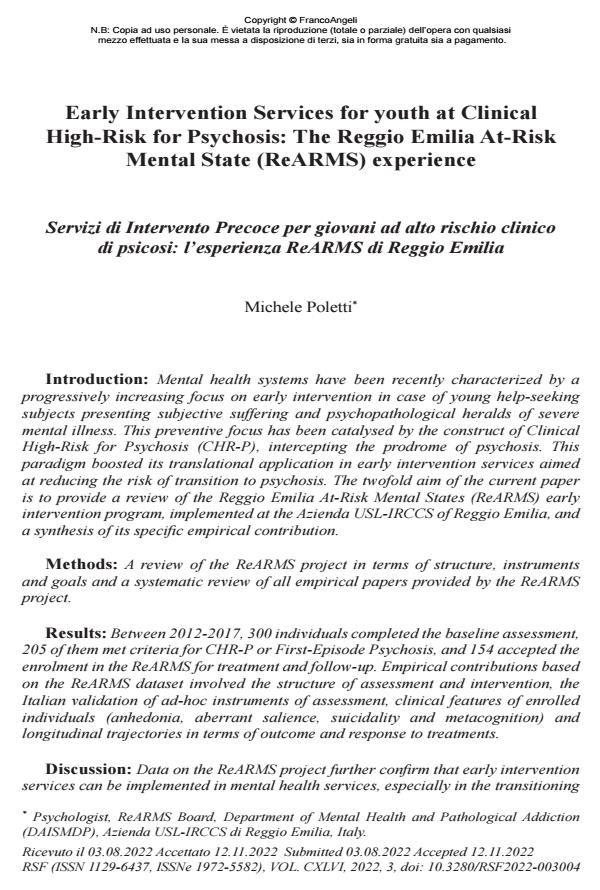Early Intervention Services for youth at Clinical High-Risk for Psychosis: The Reggio Emilia At-Risk Mental State (ReARMS) experience
Titolo Rivista RIVISTA SPERIMENTALE DI FRENIATRIA
Autori/Curatori Michele Poletti
Anno di pubblicazione 2022 Fascicolo 2022/3
Lingua Inglese Numero pagine 20 P. 61-80 Dimensione file 187 KB
DOI 10.3280/RSF2022-003004
Il DOI è il codice a barre della proprietà intellettuale: per saperne di più
clicca qui
Qui sotto puoi vedere in anteprima la prima pagina di questo articolo.
Se questo articolo ti interessa, lo puoi acquistare (e scaricare in formato pdf) seguendo le facili indicazioni per acquistare il download credit. Acquista Download Credits per scaricare questo Articolo in formato PDF

FrancoAngeli è membro della Publishers International Linking Association, Inc (PILA)associazione indipendente e non profit per facilitare (attraverso i servizi tecnologici implementati da CrossRef.org) l’accesso degli studiosi ai contenuti digitali nelle pubblicazioni professionali e scientifiche
Between 2012-2017, 300 individuals completed the baseline assessment, 205 of them met criteria for CHR-P or First-Episode Psychosis, and 154 accepted the enrolment in the ReARMS for treatment and follow-up. Empirical contributions based on the ReARMS dataset involved the structure of assessment and intervention, the Italian validation of ad-hoc instruments of assessment, clinical features of enrolled individuals (anhedonia, aberrant salience, suicidality and metacognition) and longitudinal trajectories in terms of outcome and response to treatments. age between adolescence and young adulthood, being effective in intercepting an early and usually enduring psychopathological suffering, independently from the transition to psychosis. Rather than being rigidly focused on homotypic trajectories from CHR-P to psychosis, increasing evidence on heterotypic trajectories starting from CHR-P to multiple psychopathological outcomes suggest to update early intervention services toward increased organizational flexibility, for example in therapeutic options.
Tra il 2012 e il 2017, 300 persone hanno completato la valutazione di base, 205 di loro hanno soddisfatto i criteri per CHR-P o primo episodio psicotico e 154 hanno accettato di partecipare al progetto ReARMS rispetto al successivo percorso di trattamento e monitoraggio. I contributi empirici basati sul dataset ReARMS hanno riguardato la struttura della valutazione e dell’intervento, la validazione italiana di strumenti di valutazione ad hoc, le caratteristiche cliniche degli individui arruolati (quali anedonia, salienza aberrante, suicidalità e metacognizione) e le traiettorie longitudinali in termini di esito e risposta ai trattamenti. Discussione: I dati del progetto ReARMS confermano che i servizi di intervento precoce possono essere implementati nei servizi di salute mentale, specialmente nell'età di transizione tra l’adolescenza e la giovane età adulta, essendo efficaci nell’intercettare una sofferenza psicopatologica precoce e solitamente duratura, indipendentemente dal passaggio alla psicosi. Piuttosto che essere rigidamente focalizzati sulle traiettorie omotipiche dalla CHR-P alla psicosi, l’evidenza crescente sulle traiettorie eterotipiche, da uno stato di rischio psicotico a molteplici esiti psicopatologici, suggerisce di aggiornare i servizi di intervento precoce verso una maggiore flessibilità organizzativa, ad esempio nelle opzioni terapeutiche.
Parole chiave:Alto rischio clinico per la psicosi; Servizi di Intervento Precoce, Progetto ReARMS; Progetto Regionale Esordi Psicotici.
Michele Poletti, Early Intervention Services for youth at Clinical High-Risk for Psychosis: The Reggio Emilia At-Risk Mental State (ReARMS) experience in "RIVISTA SPERIMENTALE DI FRENIATRIA" 3/2022, pp 61-80, DOI: 10.3280/RSF2022-003004